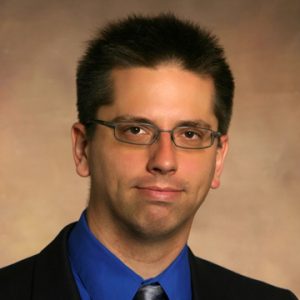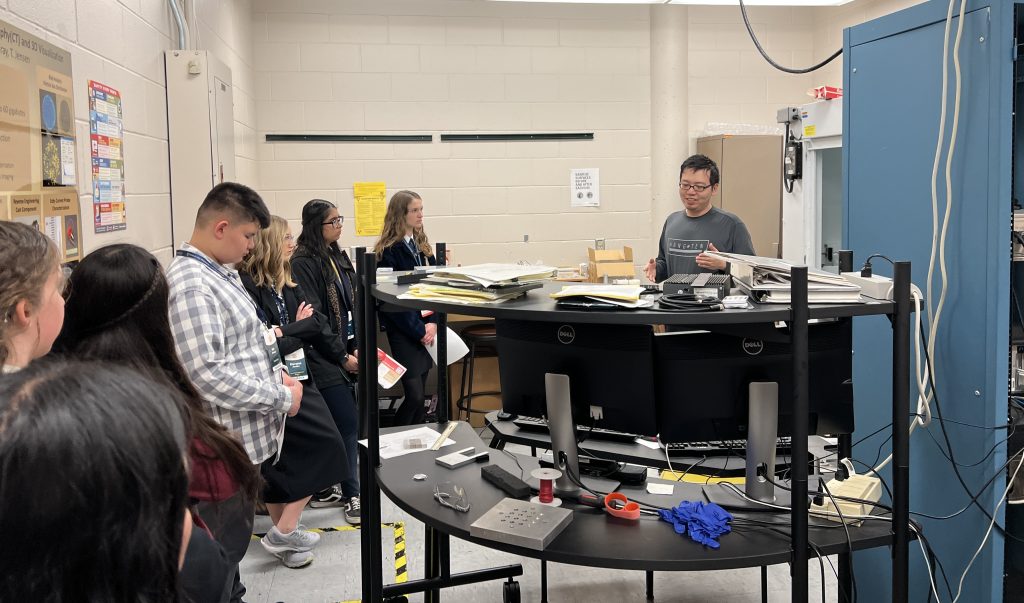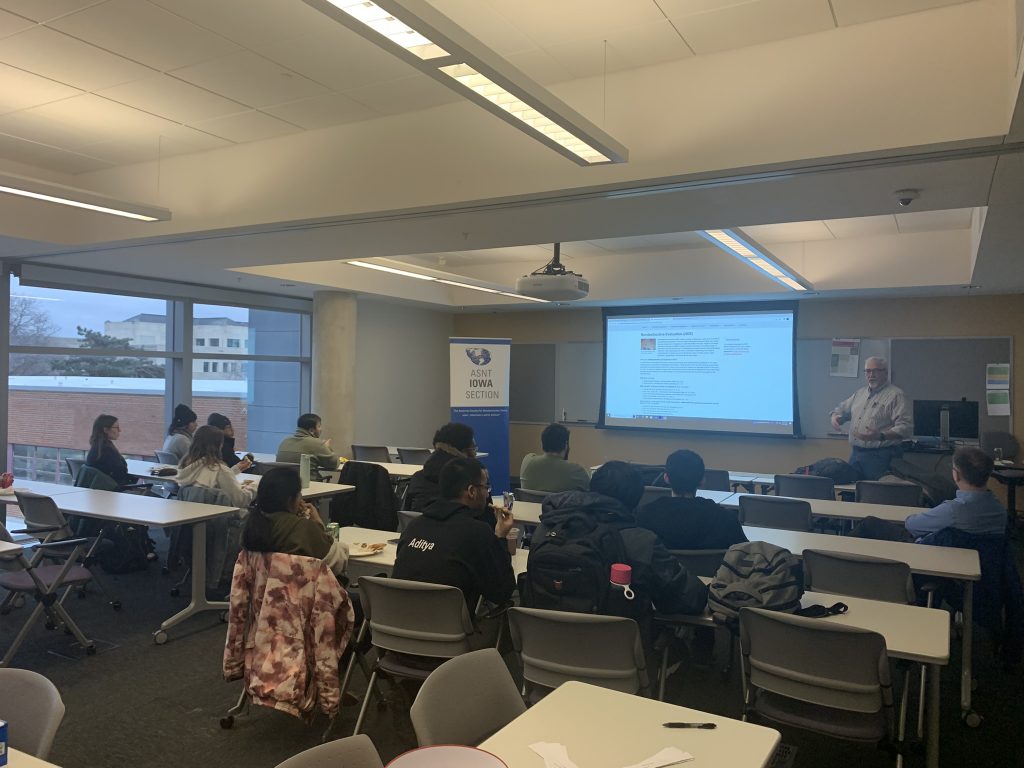We are excited to announce our 2024 webinar list has been finalized.
To see the list of webinars click here.
We are excited to announce our 2024 webinar list has been finalized.
To see the list of webinars click here.
Farzaneh Ahmadi, a Ph.D. student in the Electrical and Computer Engineering (ECpE) department, is the recipient of the Research Excellence Award presented by ISU’s Graduate College. This award is in recognition of her outstanding research accomplishments in a graduate program. Her research focus involves developing In-line nondestructive evaluation methods for polymer- and metal-based additive manufacturing (AM) processes under the direction of Dr. Reza Zoughi through the Center for Nondestructive Evaluation (CNDE).
The intent of this program is to recognize “the best of the best” graduating students. This award aims to recognize graduate students for outstanding research accomplishments as documented in their theses and dissertations. Students are expected to be academically superior and able to not only do the research but also to develop a well-written product.
Featured Researcher
Name: Stephen Holland

How long have you been at CNDE? Since 2002
Area(s) of expertise: Thermography, ultrasound, NDE data integration and digital twin
Who or what inspired you to pursue your career in NDE? I stumbled across laser ultrasonics as a student intern at Sandia Labs because it was a more interesting topic than boring virtual reality computer work. Back at university, I was inspired to continue after starting undergraduate research in Wolfgang Sachse’s lab. Five years later, I had my PhD and started at Iowa State.
Briefly describe one of your technical contributions to the NDE field. Discovery and explanation of the significance of a zero-group-velocity plate wave resonance that dominates air-coupled ultrasonic transmission, is fundamental to impact echo testing of civil structures, and also important in laser ultrasound.
What advice would you give a researcher just starting out in the NDE field? To study as much math and engineering physics as you can.
Name: Henry Moldenhauer
Research areas of interest: Thermography, solid mechanics modeling for NDE, resonant testing for materials characterization.
Anticipated graduation date: December 2024
Who or what inspired you to pursue your studies in NDE? During my final year as a civil engineering student, I looked into graduate programs in engineering mechanics. I g ot in contact with Dr. Stephen Holland at the Center for Nondestructive Evaluation (CNDE) and became one of his students. Before this, I had little knowledge of NDE, but I grew to appreciate the wide variety of topics within the field. The types of problems and projects that I have had the opportunity to work on with Dr. Holland and others at CNDE have really cemented my interest in the field.
ot in contact with Dr. Stephen Holland at the Center for Nondestructive Evaluation (CNDE) and became one of his students. Before this, I had little knowledge of NDE, but I grew to appreciate the wide variety of topics within the field. The types of problems and projects that I have had the opportunity to work on with Dr. Holland and others at CNDE have really cemented my interest in the field.
Briefly describe something you have learned or discovered during your time at CNDE that surprised you. I was most surprised by how interdisciplinary the field of NDE is. I’ve found it to be more of an intersection of many interesting fields. On a single project, you may have researchers with experience in different NDE modalities (e.g. electromagnetic methods, ultrasound, thermography, etc.) as well as researchers specializing in other topics like statistics or computational methods. This interdisciplinary approach has not only allowed me to build a much broader background of information, but it has also allowed me to contribute to a much wider variety of projects than I might have in other fields.
What are your future career plans? I am actively exploring opportunities within the field of NDE. My main goal is to continue to be able to work on solutions to a variety of interesting problems. If possible, I want to find ways to share what I have learned with others interested in NDE.
Henry is the recipient of the O.D. & O.U. Trapp Graduate Fellowship through CNDE.
Name: Anna Case
Research areas of interest: Microwave and millimeter wave materials characterization

Who or what inspired you to pursue your studies in NDE? As a sophomore in electrical engineering, I was hired by Dr. Zoughi to work in the Applied Microwave Nondestructive Testing Lab. At the time, I was happy to have the opportunity but didn’t know if it would lead to a career. Several years later, I can say that everyone I work with, including my mentor, David Moore from Sandia National Labs, has continued to encourage me to stay in the field.
Briefly describe something you have learned or discovered during your time at CNDE that surprised you. What surprised me the most about coming to CNDE was the difference in work as an undergraduate and as a graduate research assistant. As an undergraduate student, you are given very specific tasks to accomplish, while as a graduate student, you have more open-ended questions to answer. It’s important to continue to state the tasks you perform so that you know what you have done – even if it doesn’t always answer the question at first.
What are your future career plans? I am joining the NDE team at Sandia National Labs in Albuquerque, NM. I hope to expand my NDE experience with CT, ET, and UT. I plan to stay involved with the American Society of Nondestructive Testing (ASNT) and the Institute of Electrical and Electronics Engineers (IEEE).
Anna is the recipient of the O.D. & O.U. Trapp Graduate Fellowship through CNDE.
CNDE Director, Dr. Reza Zoughi is the recipient of the 2023 American Society for Nondestructive Testing (ASNT) Lester/Mehl Honor Lecture. The purpose of the Lester/Mehl Honor Lecture is “to recognize individuals who have made outstanding contributions to the science of nondestructive testing. Such contributions may be made in the area of research, applications technology, management, education, equipment development, or other related areas. Nominees must have made outstanding contributions to the science of NDT. Such contributions may be in the area of research, applications, technology, management, education, equipment development, or other related areas.”
Farzaneh Ahmadi, CNDE Graduate Research Assistant, will be presenting:

as part of the Lawrence Livermore National Laboratory (LLNL) – Nondestructive Characterization Institute (NCI) Seminar Series
August 17, 2023
1:00 pm (CST)
ABSTRACT: Polymer-based additive manufacturing (AM) has found extensive application in various industries, including medical and aerospace, owing to its rapid and cost-effective process. Nevertheless, real-time monitoring of the printed parts continues to face challenges and issues. This study compares the effectiveness of three near-field millimeter wave probes – open-ended rectangular waveguide (OERW), dielectric-loaded waveguide (DLW), and extended dielectric-loaded waveguide (EDLW) – in detecting small voids and moisture absorption in polylactic acid (PLA) filaments commonly used in polymeric AM. Dielectric inserts serve as a field concentration tool, potentially improving the spatial resolution of the probes. Numerical electromagnetic simulations were performed at Ka-band (26.5-40 GHz) and V-band (50-75 GHz) using CST Studio Suite® to detect small hemispherical voids and moisture absorption in the feedstock, respectively, followed by experimental validation. The results of the study indicated that, at V-band (50-75 GHz), the spatial resolution of the standard OERW probe was deemed sufficient for detecting small surface voids in stock PLA filaments. In terms of moisture detection, the EDLW probe at Ka-band (26.5-40 GHz), exhibited the highest sensitivity, when loaded with a material possessing a dielectric constant similar to that of the inspected filament.
BIO: Farzaneh Ahmadi received her B.S. degrees in electrical engineering from Shahid Rajaee University (Tehran, Iran) in 2010 and her M.S. degree in electrical engineering from Tarbiat Modares University (Tehran, Iran) in 2012. She is currently working towards her Ph.D. degree in Electrical and Computer Engineering (ECpE) at Iowa State University (ISU). Her research at the ISU Center for Nondestructive Evaluation (CNDE) involves developing In-line nondestructive evaluation methods for 3D printed structures, especially polymers and metals. She is a recipient of CNDE R. B. Thompson Fellowship, the 2023 American Society for Nondestructive Testing (ASNT) Student Travel Grant Award, and the 2022 ASNT Best Student Paper Award (2nd place).
Congratulations Pete Collins (CNDE, Materials Science and Engineering), Maria Jose Quintana (Materials Science and Engineering), and Yuan Ji! Their paper, “A Perspective Of The Needs And Opportunities For Coupling Materials Science And Nondestructive Evaluation For Metals-Based Additive Manufacturing” was selected by ASNT as the 2023 Outstanding Paper.
This paper attempts to provide a bridge between two traditionally separated technical communities, namely the NDE and AM communities. By providing a brief review of the state-of-the-art of relevant literature, it serves to give a foundation to understand what materials details need to be understood, what information methods may provide, and the possible research pathways going forward.
 Name: Trent Moritz
Name: Trent Moritz
Research areas of interest: Microwave and millimeter wave nondestructive testing and material characterization.
Anticipated graduation date: Spring 2026
Who or what inspired you to pursue studies in NDE? While taking Electromagnetics with Dr. Mani Mina, he told me about CNDE (which up to that point, I did not know existed) and that they were looking for undergraduate students to work in their labs. After hearing a brief description of what they do, I found it interesting and asked Dr. Reza Zoughi if they were still looking for students. Fortunately they were and very quickly after joining as an undergraduate research assistant in their labs, I found that I really enjoyed NDE and all the pieces that go into it. While there are many things along the way that led to me pursuing a PhD in NDE, it was mainly the people (Dr. Mina and everyone I have worked with at CNDE) that got me interested in the field and made me want to stick around.
One thing I have learned that surprised me: The biggest thing that surprised me is how little I knew in terms of practical knowledge in NDE coming out of my undergrad. I knew there was going to be somewhat of a learning curve, but I thought with my theory from courses I would be able to quickly figure things out. This was not the case. I have enjoyed the process of learning how to perform NDE and it is something I am still doing to this day.
Future career plans: I would like to stay in the NDE field, but I am not sure where that will be.
Trent is the first CNDE-GRA recipient and also the recipient of the O.D. & O.U. Trapp Graduate Fellowship in CNDE.

Reza Zoughi, CNDE Director, Kirby Gray (Battelle) Chair in Engineering, and Professor of Electrical and Computer Engineering, has been recognized as one of IEEE Xplore’s Featured Authors.
Featured abstract entitled: “Wideband Microwave Camera for Real-Time 3-D Imaging”.
 Anna Case, a Ph.D. student in Electrical Engineering, was the recipient of the Best Graduate Presentation Award given by the Graduate Seminar Committee in the ECpE Department.
Anna Case, a Ph.D. student in Electrical Engineering, was the recipient of the Best Graduate Presentation Award given by the Graduate Seminar Committee in the ECpE Department.
Her presentation was entitled: “Millimeter Wave Thickness Evaluation of Thermal Barrier Coatings (TBCs) Using Open-Ended Waveguide Probes“.
Anna received a certificate and $200 check.
CNDE hosted the largest Spring 2023 Industrial Advisory Board (IAB) Meeting on April 17-19.
IAB members from ATI, Boeing, General Motors, Honeywell Aerospace, John Deere, NASA Langley Research Center, Naval Nuclear Laboratory (NNL), Northrop Grumman, Pacific Northwest National Laboratory (PNNL), Pratt & Whitney, Rolls-Royce, and USAF-AFRL-RXNW were in attendance, as well as invited guests from seven other industries.
Graduate students and faculty members from MSE and ECpE showcased their research projects on April 17.

On April 18, students were able to connect with our members and guests during the Pizza with Students event at the Student Innovation Center.

Thank you to all who were able to attend!

It is with great pleasure to announce the addition of Cummins Inc. to the CNDE family as an Affiliate Member.
We are very excited about the potential opportunities to engage and collaborate with our Cummins colleagues. Welcome!
 CNDE participated in this years Iowa State University Extension and Outreach 2023 State Science + Technology Fair of Iowa on March 30 & 31. This 2-day fair was for students ranging from grades 6 – 12 and provided a space to showcase their research projects. Students got the chance to meet with professionals in all areas of science and technology.
CNDE participated in this years Iowa State University Extension and Outreach 2023 State Science + Technology Fair of Iowa on March 30 & 31. This 2-day fair was for students ranging from grades 6 – 12 and provided a space to showcase their research projects. Students got the chance to meet with professionals in all areas of science and technology.
We welcomed 15 students to our labs, who met with our researchers. This was a great opportunity to introduce students to NDE at a young age.




CNDE also sponsored several cash prize awards for the top NDE related research projects. Two NDE Minor students graciously volunteered their time and judged these projects.
1st Place: Andrew Salrin Project Title: Ventilation Prototype Utilizing Additive Manufacturing and Ionic Thrust Phase II
2nd Place: Judith Williams Project Title: Implications of Grass Fiber Ratio of Paper on Mechanical Properties
3rd Place: Carter Hageman Project Title: Impacts of Infill Density and Pattern Variations on Structural Integrity
1st Place: Diedrick Schnieders Project Title: What 3D Printed Filament is the Strongest?
2nd Place: Logan Brown Project Title: Is Your Concrete REALLY Concrete?
3rd Place: Carson Morrison & Brett Cook Project Title: The Physics of Golf Balls

On February 24, the Iowa Section of ASNT hosted a dinner for engineering students on campus. Twenty-five students were in attendance that included undergraduate and graduate students from both Electrical and Mechanical Engineering. They enjoyed free pizza and raffle prizes, while learning about the NDE opportunities available at Iowa State University.


